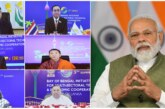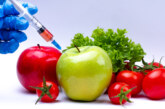Water conservation entails harnessing of the available water resources for the best beneficial use with all the technological and policy measures at command. Reduce, recycle and reuse should be our mantra, says Dr. Arvind Kumar.
 INDIA, which is home to 16% of the world’s population, has only 2.5% of the world’s land area and 4% of its water resources. Precipitation in the form of rain and snowfall provides over 4,000 trillion litres (TL) of fresh water to the country. Most of this freshwater is carried out to the sea and ocean via the many large rivers flowing across the subcontinent. A portion of this water is absorbed by the soil and is stored in underground aquifers.
INDIA, which is home to 16% of the world’s population, has only 2.5% of the world’s land area and 4% of its water resources. Precipitation in the form of rain and snowfall provides over 4,000 trillion litres (TL) of fresh water to the country. Most of this freshwater is carried out to the sea and ocean via the many large rivers flowing across the subcontinent. A portion of this water is absorbed by the soil and is stored in underground aquifers.
A much smaller percentage is stored in inland water bodies including natural lakes and ponds and man-made tanks and reservoirs. According to broad estimates, out of the 1,869 TL of water reserves in the country, only an estimated 1,122 TL can be utilised due to topographic constraints and distribution issues. Furthermore, the past few decades have witnessed rapid increase in demand for water. India’s current water consumption is approximately 581 TL, with irrigation needs accounting for a staggering 89%, followed by domestic use at 5% and industrial consumption at 6%.
Viewed in a broad spectrum, the total water demand is projected to increase by 22% by 2025, and 32% by 2050 and a major part of the additional water demand will be for the domestic and industrial sectors. The water demands of the domestic and industrial sectors will account for 8% and 11% of the total water demand by 2025 and by 2050 these shares will increase to 11% and 18%, respectively. Moreover, the domestic and industrial sectors will account for 54% of the additional water demand by 2025, and more than 85% by 2050.
Water is a finite source and additional water demand can be met only through water conservation, rainwater harvesting and recycling of waste water for reuse. Broadly speaking, water conservation is a comprehensive term that encompasses efficient use of water, recycling of waste water for reuse and water conservation through rainwater harvesting.
The 3Rs of Water Conservation
Water conservation entails harnessing of the available water resources for the best beneficial use with all the technological and policy measures at command. It is based on 3Rs – reduce, recycle and reuse. In other words, it refers to reducing the usage of water, recycling of waste water and reuse of waste water for different purposes such as cleaning, manufacturing and agricultural irrigation.
Apart from being an action warranting a device or technology or improved design or process implemented to reduce water loss, waste, or use, water conservation also emphasises on behavioural change of the user. Water efficiency is a tool of water conservation that culminates in more efficient water use and thereby leading to reduction in water demand. The urgency for water conservation in Indian context assumes immense significance in view of the fast depletion of groundwater resources, pollution of surface water resources and rapid pace of melting of Himalayan glaciers. Water conservation is the most cost-effective and environmentally sound way to reduce our demand for water. Using less water also puts less pressure on our sewage treatment facilities, and uses less energy for water heating. Saving water also saves energy.
Necessity for water conservation arises for restoration of the fast deteriorating ecosystem and to meet the inevitable emergency of shortage even for drinking and domestic water needs in the near future. It also aims at envisaging a semblance of equilibruim between demand and supply. Undoubtedly, water resources are ‘renewable’ through hydrological cycle, nevertheless, what is renewable is only the quantity, but pollution, contamination, climate change, temporal and seasonal variations have affected the water quality and reduced the amount of ‘usable water’.
Water conservation is helpful in ensuring sustainable supply of water. It also helps in conservation of energy because about 15% of total electricity consumption is devoted to water management in the form of water pumping, delivery, and wastewater treatment facilities; and water conservation could lead to less consumption of energy. Water conservation through minimising human water use can lead to ‘Habitat Conservation’ thereby helping to preserve fresh water habitats for local wildlife and migrating waterfowl, as well as reducing the need to build new dams and other water diversion infrastructures.
Water conservation strategies
The strategies for water conservation can be demand-oriented or supply-oriented and/or management-oriented. These strategies may vary depending upon the field of water use that can be domestic, for irrigation or industrial.
Domestic sector
Water saving for domestic purpose can be facilitated through low-flow shower heads, dual flush toilets that use up to 67% less water than conventional toilets, using harvested rain water for flushing toilets; faucet aerators – which break water flow into fine droplets to maintain “wetting effectiveness” while using less water, using high-efficiency clothes washers, using low flow taps in wash basins and automatic faucet. Capacity building of the residents with the help of RWAs (Residents Welfare Associations) for water conservation is necessary to create awareness to make basic attitude change.
Agricultural sector
Agriculture is the biggest consumer of fresh water and appropriate water conservation in agriculture sector is direly needed. Accordingly, water saving in agricultural sector can be facilitated by means of reducing the flooding type system by adopting sprinkler/drip type systems, planting water-efficient variety of crops, by use of soil moisture and rainfall sensors to optimise irrigation schedules. Besides, large gains in efficiency are possible through measurement and more effective management of the existing irrigation system.
Industrial sector
Industrial sector in India is the second largest consumer of water. Industrial water use can be grouped into three main categories: heat transfer, power generation and use in industrial processes. Water conservation and water use efficiency in industrial sector can again be facilitated through 3R’s: Recycling of waste water, Reuse of recycled water and Reduction in consumption of water. Two basic activities of measuring the amount and monitoring the quality of the water are essential for effective implementation of 3Rs. Recycled waster water can be put to reuse for washing processes and also in cooling equipment that generates heat.
Conclusion
Water conservation is an important tool for reducing water demand, and limiting water use should be an everyday practice for people and businesses. Water conservation may require changing old habits and re-thinking the way we do things. The recent decision of Union Ministry of Water Resources to observe 19 November as Water Conservation Day to create awareness about the need to conserve water is a laudable move.
Improvement in operation and maintenance is essential to stem huge loss of water. For developing water resources, traditional water conservation methods should be adopted in conjunction with modern conservation technology. Rain water harvesting should be made mandatory where applicable and recycling of wastewater may be incorporated wherever feasible. Water audit should be conducted categorically in two systems, resource audit or supply side audit and consumption audit on demand side.
There is also need for capacity building of the people by sensitising, incentivising and galvanising them about water conservation. There is a need to activate local processes, energise people and institutions, towards process visibility of policies and practices related to water conservation.
By Dr. Arvind Kumar, President, India Water Foundation



